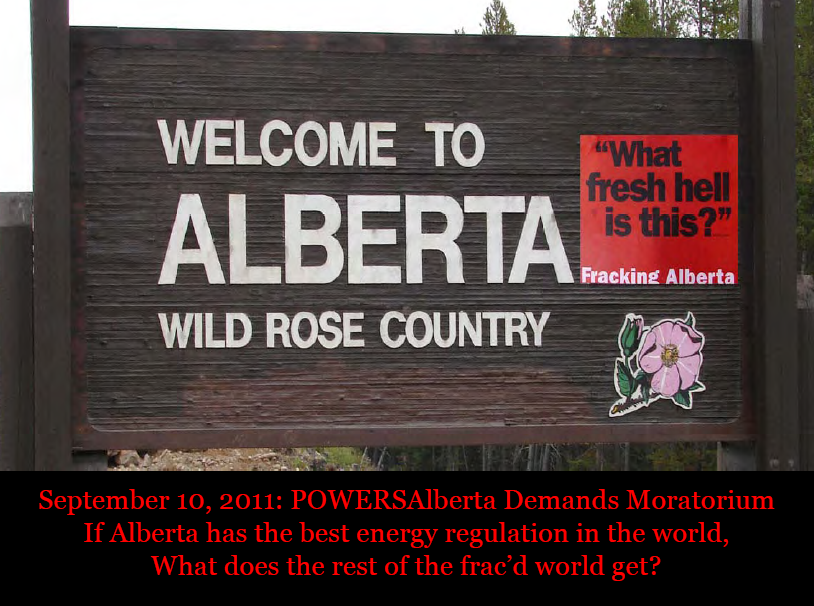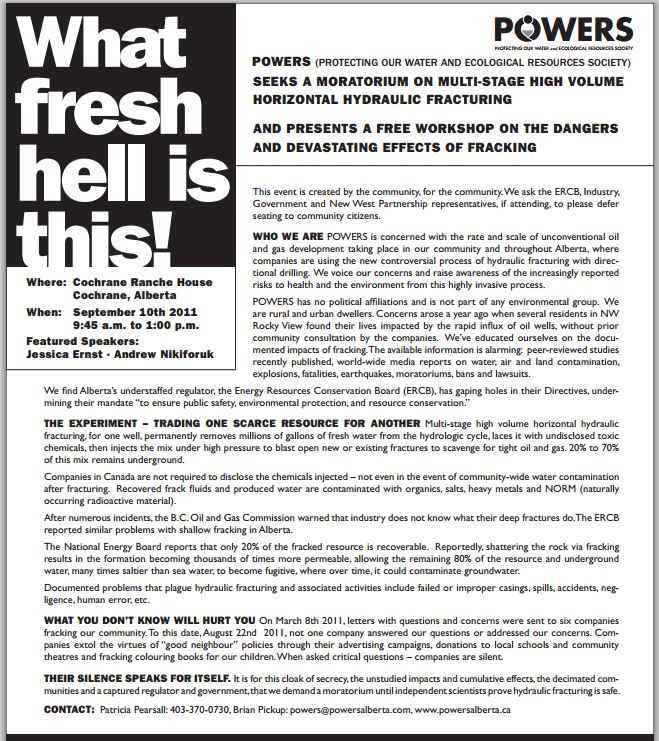“A proportion (25% to 100%) of the water used in hydraulic fracturing is not recovered, and consequently this water is lost permanently to re-use, which differs from some other water uses in which water can be recovered and processed for re-use.” AEA, 2012
BNN Interviews Alberta Oil Patch Consultant Brent Nimeck on Lexin and AER’s Orphan Wells: “This problem is 30 years in the making. … I would call it a Ponzi Scheme…. This is an orchestrated fraud from multiple angles: Industry, CAPP and the Alberta Energy Regulator have enabled this to happen. … Through our independent analysis and we’ve confirmed this at multiple sources within the energy regulator, the liabilities are over $300 billion. That’s what’s on the hook for Alberta taxpayers right now – $300 billion.” (That was in 2017. AER and Alberta politicos allow the liabilities, contamination and health harms to grow and grow and grow and grow, as they fill their con pockets.)
Oil Wells Creeping Into Texas Cities Herald Shale Era’s Twilight by David Wethe and Kevin Crowley, Bloomberg, December 12, 2022, Yahoo!Finance
Each morning when Michael Quinn pulls into the parking lot of the luxury apartment complex he manages in West Texas and looks across the street, an unsightly vision blots the horizon: a 24-foot-high insulated wall.
Quinn, who works at the Midway Station Apartments in Midland, isn’t troubled by the eyesore. The barrier, covered in a sand-colored tarp, is designed to muffle noise from an oil-well site across the road. To Quinn, it’s a symbol of a flourishing industry that’s the lifeblood of the local economy.
But it actually tells a very different story: The wall, and an accompanying surge in urban drilling, is the latest sign that America’s shale fields are reaching middle age.
An uptick in drilling within the city limits signals that the very best rock in one of the world’s most prolific oil fields has already been tapped. In the shale boom’s early days, with so much crude-soaked land up for grabs elsewhere in the Permian Basin, there was little reason to deal with the red tape needed to bore underneath populated areas. But with over two-thirds of the Permian’s premium land now drilled, according to BMO Capital Markets, producers are seeking more permits than ever to burrow beneath Midland and its 130,000 residents.
Observers have long been predicting shale’s demise or heralding its rebirth. But this time is different: After years of honing their craft to boost output, producers in the Permian’s two main zones are pumping less oil per foot drilled in each new well, not more.
Output guidance from Exxon Mobil Corp., Chevron Corp. and Devon Energy Corp. has shown that US shale growth is coming in at the low end of expectations. Analysts say the Permian could reach a production plateau within five years.
That’s a problem that reaches far beyond Texas. US shale, led by the Permian, has provided 90% of global oil output growth in the past decade, according to research firm Enverus. It made the US the biggest producer ahead of Saudi Arabia. A shale slowdown means the world can no longer rely on the US to be its swing oil supplier, capable of ramping up or down quickly to temper a volatile market. It complicates the Biden administration’s efforts to tame pump prices, and it hands more power back to OPEC as Russia’s invasion of Ukraine upends oil and gas supply.
“US supply is already materially slowing down,” said Francisco Blanch, head of commodities research at Bank of America Corp. “It’s giving OPEC a lot of comfort to come in and keep prices elevated because they don’t fear US shale like they did in the past.”![]() Pffft. I don’t think OPEC was afraid of US frac’ers. I think OPEC has a lot of patience, enough to wait and watch the demise of North America’s frac fraud. Investors that got caught in the con, have lost billions of dollars. I expect OPEC is laughing at us idiots getting slaughtered in North American frac fields.
Pffft. I don’t think OPEC was afraid of US frac’ers. I think OPEC has a lot of patience, enough to wait and watch the demise of North America’s frac fraud. Investors that got caught in the con, have lost billions of dollars. I expect OPEC is laughing at us idiots getting slaughtered in North American frac fields.![]()
The Permian Basin sprang into the public consciousness about a decade ago as new fracking techniques transformed what was thought to be a depleted oil field into some of the most desirable acreage on the planet. Crucially, US shale’s spectacular growth — adding more crude to global markets from 2012 to 2020 than the entire current production of Iraq and Iran combined — became a thorn in the eye of OPEC, which saw its market dominance threatened like never before.![]() Such hooey.
Such hooey.![]()
But US output tumbled at the start of the Covid-19 pandemic and is still about 1 million barrels a day below the record 13 million reached in early 2020. Next year, growth is likely to be around 560,000 barrels a day, according to Enverus. That’s despite crude prices averaging more than $90 a barrel this year, far above what producers need to break even.
Skyrocketing costs for labor and equipment, as well as pressure to return more cash to shareholders, are partly to blame for drillers’ restraint. Rising interest rates, meanwhile, likely herald the end of cheap money for shale producers looking to finance even modest growth plans. But a new, more troubling trend has emerged in recent weeks: The rock itself is yielding less oil.
Wells drilled this year produced between 8% and 13% less oil per lateral foot than a year earlier, according to BloombergNEF, the first major reversal after a decade of productivity gains. Pioneer Natural Resources Co., one of the biggest Permian operators, recently overhauled its drilling plan after executives were “not satisfied” with its well performance this year.
Laredo Petroleum Inc. said some of its production was hurt by interference from other wells nearby.
A higher proportion of drilling is now done by private companies, which aren’t beholden to shareholder pressure to boost buybacks and dividends. But that’s contributing to lower productivity, according to Phillip Jungwirth, an analyst at BMO Capital Markets.
Private producers tend to have less-desirable acreage, he said. Some public and private companies are using a method known as multi-zone development, which means they’re drilling several layers of shale at once to improve efficiency, but in doing they’re also tapping their less-productive rock. BMO estimates that most of the top-tier land has already been developed in the Permian and in the Bakken of North Dakota, the top-producing shale regions. That leaves explorers with a lower inventory of the most valuable yet-to-be-drilled sites.
“We’re going to run out of inventory in the next four to six years,” said James West, an analyst at Evercore ISI. “We probably saw it earlier in other shales, which is why we left those other shales and moved so much activity into the Permian. It’s now rearing its ugly head in the Permian.”
Midland, the largest town in the Permian, has fielded 100 applications so far this year to drill within city limits, said Ron Jenkins, the city’s oil and gas coordinator. That’s nearly double last year’s total and the highest since Midland instituted a city ordinance for in-town drilling in 2010.
Though the Permian is running out of premium rock, it isn’t grinding to a halt by any stretch. Production there is expected to keep growing for at least the next few years, although at a more measured pace compared with the height of the shale boom.
To gain an advantage, some large publicly traded US producers have made acquisitions in a bid to boost their access to top-tier acreage.
“The forward-thinking companies are getting additional acreage to complement their plays as strategically as possible,” said Sara Harris, executive director of Midland Development Corp., the city’s economic-development arm. But, she cautioned, too many people have wrongly called the death-knell for the Permian over the years. “Then with new technologies it turned out there were a lot more resources to be had.”
Economic woes around the world have helped push oil prices lower in recent weeks. But if the Permian’s growing pains continue, then the world oil market could lose its biggest growth engine, putting power back in the hands of OPEC and Saudi Arabia’s Crown Prince Mohammed Bin Salman.
“The Saudis and OPEC have waited this out,” said John Hess, chief executive officer at Hess Corp., which drills in the Bakken. “Now, really OPEC is back in the driver seat.”

Refer also to:
Frac’ing greed & insanity: More billions of frac dollars to go down the drain



Big Oil and Gas industry writing down billions in U.S. shale gas assets

